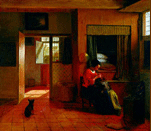










32.
Publicizing Private Space, 1400-1650
Organizers:
Description:
Much of the scholarship positioning women in early modern European culture has been formulated around the concept of women and the private sphere. Since many women were confined to the home and the domestic environment, their influence in the wider world has been deemed limited. However, scholars are now discovering a much more fluid relationship between public and private space. The home was the location of important dynastic events in which women played key roles as participants and organizers; these events included weddings, births, baptisms, and funerals. But the significance of such events traveled far beyond these domestic walls, exerting a powerful impact on all areas of public life. Moreover, the home of the female administrator or ruler, just like that of a male in this position, was a political arena, and the success of her negotiations often depended upon how she fashioned her physical environment. The gendering of space, both public and private, is a topic that deserves much further attention.
In many ways, the fundamental reading for this workshop is the section from Leon Battista Alberti’s De Re Aedificatoria (circa 1450) in which he describes the importance of the home as a microcosm of the city. Alberti is best known among feminist scholars for his assertion that women should be suppressed at all costs from taking part in public life. But his recognition that successful homes made successful cities seems to contradict that belief. As such, a re-reading of Alberti can initiate new interpretations of the relationship between women and their public and private environments. Additional readings will expand the focus on the relationship between women and domestic architecture to other centers in Renaissance and Baroque Europe. This workshop will thus allow its participants to engage with a broad range of material regarding women and the built environment, from the architectural mechanisms, fabric, and furnishings of the home, to such issues as the enactment of ritual, ceremony, and role-playing within that space, all within the context of public and private life.
This workshop will begin with no more than fifteen minutes of
introduction, where all participants will introduce themselves and each organizer
will present a brief slide-based statement of her interests in this topic.
We will then move on to a group discussion, opening the floor to broader examinations
of the various themes raised by the readings and the interests of our workshop
participants. Possible topics might include prominent women and the role of
the built environment in their self-fashioning, or the ways that ritual objects
function in the built environment. Our readings further these interests through
case studies from France, England, Italy, and the Dutch Republic. We encourage
workshop participants to bring brief photocopied material or a slide to familiarize
the group with their own particular work and to stimulate further discussion
on the role of women in the relationship between public and private space
in early modern Europe.
Preliminary List of Readings and Images:
Suggested Reading:
|
|
|
||||||
|
|
 |
 |
|
||||
 |
|
 |
|
||||
|
|
|
||||||
|
|
|
||||||
 |
|
||||||
|
|
|
||||||
| |
|
||||||
 |
|
||||||
 |
|
||||||
 |
|
||||||
 |
|
||||||
|
|
|
||||||
|
|
 |
|
|
||||
 |
|
||||||
|
|
|
|
|
|
|
|
|